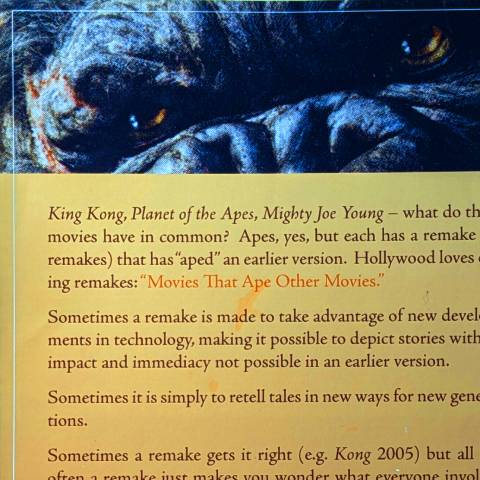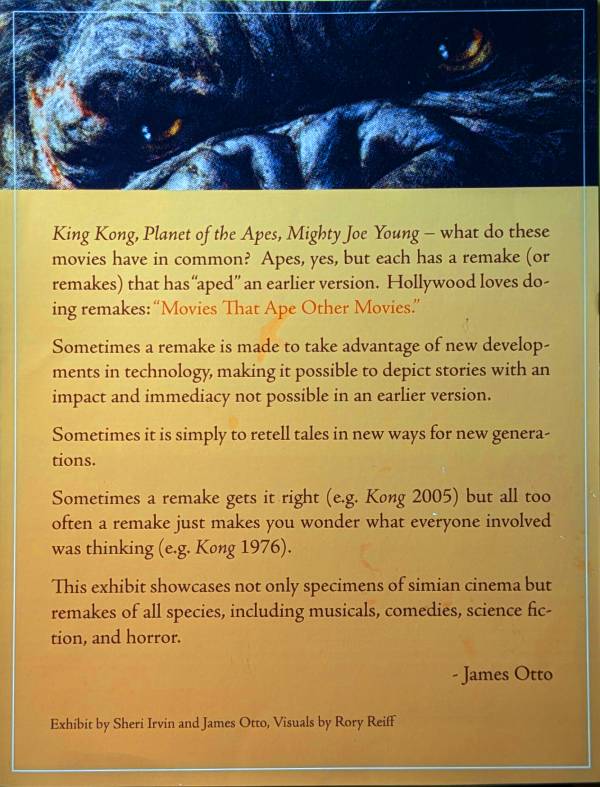Exhibit Essay

Project Details
In my time at the Claremont Colleges Library, I curated or co-curated a few exhibitions and wrote their text. “Movies That Ape Other Movies” was curated by Librarian Sheri Irvin and me, with an essay by me and a poster designed by Rory Reiff.

Exhibit Text
Exhibit: Movies That Ape Other Movies
(Films featured in our exhibit are indicated in bold. Directors and release dates are usually mentioned parenthetically.)
King Kong, Planet of the Apes, Mighty Joe Young – what do these movies have in common? Apes, yes, but each has a remake (or remakes) that has “aped” an earlier version. Hollywood loves doing remakes: “Movies That Ape Other Movies.” Sometimes a remake is made to take advantage of new developments in technology, making it possible to depict stories with an impact and immediacy not possible in an earlier version. Sometimes it is simply to retell tales in new ways for new generations.
The centerpiece of our exhibit is King Kong (Cooper & Schoedsack, 1933), one of the groundbreaking special effects films. Willis O’Brien’s animation of the eponymous ape may seem creaky to generations spoiled by Industrial Light and Magic and photorealistic digital animation but it had filmgoers fainting in the aisles in 1933. After the passage of forty years producer Dino De Laurentiis attempted a remake (King Kong, Guillermin, 1976) that was intended to showcase the robotic special effects of Carlo Rambaldi but ended up requiring Rick Baker to provide a then state-of-the-art ape suit when the robo-Kong did not function as well as expected. Most recently, Peter Jackson directed what is in many ways the ultimate version (King Kong, 2005), with modern digital animation that gave added dimensions to the title character.
A science fiction film with an ape theme was Planet of the Apes (Schaffner, 1968), remade in 2001 by Tim Burton. Speaking of Sci Fi, the original film version of The War of the Worlds (Haskin, 1953) was itself a remake (of sorts) of the Orson Welles radio broadcast which modernized the H.G. Wells novel with a pseudo-documentary style that provoked a national panic. The ’53 War was in turn remade by Steven Spielberg (War of the Worlds, 2005), with nods to both the novel’s vision and that of the ’53 film. Though not officially a remake Independence Day (Emmerich, 1996) owes a great debt to its unmistakable source of inspiration and perhaps tips its hat in various plot details (e.g. the Martians in TWotW ’53 destroy the L.A. city hall and the aliens in ID blow up the White House).
Sources of inspiration are similarly apparent in the relationship between The Nutty Professor (Lewis, 1963) and Robert Louis Stevenson’s Dr. Jekyll and Mr. Hyde. The subject matter has been so tempting to filmmakers that Stevenson’s story has been filmed (as a theatrical feature, so this doesn’t include TV versions) in 1920, 1931 (Mamoulian), 1941, and 2002, and has been combined with gender-bending in Dr. Jekyll and Sister Hyde (Baker, 1971) and Dr. Jekyll and Ms. Hyde (Price, 1995). Jerry Lewis’ twist on the tale was popular enough to itself inspire a remake (The Nutty Professor, Shadyac, 1996).
Not so apparent are the lines of influence among some other films. High Noon (Zinnemann, 1952) was remade with an outer space setting as Outland (Hyams, 1981). And few viewers of Alien (Scott, 1979) probably realize that it was an unofficial remake of It! The Terror from Beyond Space (Cahn, 1958).
On the other hand, you can’t make the relationship of a remake to its source any more obvious than by giving it the same name, as in the two versions of Sabrina (Wilder, 1954 and Pollack, 1995). The Magnificent Seven (Sturges, 1960) similarly is a remake of a film originally released as “The Magnificent Seven,” now known in the English-speaking world as “Seven Samurai,” Kurosawa’s Shichinin no samurai (1954).
The issue of quality nags remakes nearly as much as it does sequels. Sometimes a remake gets it right – e.g. Kong 2005 – but all too often a remake just makes you wonder what everyone involved was thinking – e.g. Kong 1976. On the whole, remakes fail when they lose touch with the zeitgeist that contributed to what made the original seem worth revisiting, and succeed when they capture the spirit of the source. The Kongs are a case in point: the ’76 version attempted to update the story – usually a bad idea – and ended up with some ludicrous plot points as a result, whereas Jackson’s ’05 version retained the 1930s setting of the story and was able to deepen the ideas of the original by not wrenching them into an alien context – while wisely trying to jettison or parody the unenlightened racial stereotyping of the ’33 version.
This is why the American version of The Magnificent Seven works reasonably well – it’s a remake as a western of a samurai picture that was itself inspired by American westerns. American remakes of non- English language originals usually lose something in translation, literally or figuratively, such as the remake of the poetically episodic Wim Wenders film Der Himmel über Berlin (English title, “Wings of Desire,”1987) as the painfully plot-driven City of Angels (Silberling, 1998).
Below is a partial listing of remakes throughout the years – the good, the bad, and the ugly… which brings to mind the final film of Sergio Leone’s “Dollars” trilogy starring Clint Eastwood, its character of the mysterious stranger arguably borrowed from Shane (Stevens, 1953), which was in turn remade by Eastwood as Pale Rider (1985) … oh, this could go on forever. And probably will. [And, incidentally, has: a few of the above-mentioned films were remade again since this essay was written.]
-James Otto
[This essay originally was followed by a list of films and their remakes, as well as other films they inspired.]
Exhibit Text
Exhibit: Movies That Ape Other Movies
(Films featured in our exhibit are indicated in bold. Directors and release dates are usually mentioned parenthetically.)
King Kong, Planet of the Apes, Mighty Joe Young – what do these movies have in common? Apes, yes, but each has a remake (or remakes) that has “aped” an earlier version. Hollywood loves doing remakes: “Movies That Ape Other Movies.” Sometimes a remake is made to take advantage of new developments in technology, making it possible to depict stories with an impact and immediacy not possible in an earlier version. Sometimes it is simply to retell tales in new ways for new generations.
The centerpiece of our exhibit is King Kong (Cooper & Schoedsack, 1933), one of the groundbreaking special effects films. Willis O’Brien’s animation of the eponymous ape may seem creaky to generations spoiled by Industrial Light and Magic and photorealistic digital animation but it had filmgoers fainting in the aisles in 1933. After the passage of forty years producer Dino De Laurentiis attempted a remake (King Kong, Guillermin, 1976) that was intended to showcase the robotic special effects of Carlo Rambaldi but ended up requiring Rick Baker to provide a then state-of-the-art ape suit when the robo-Kong did not function as well as expected. Most recently, Peter Jackson directed what is in many ways the ultimate version (King Kong, 2005), with modern digital animation that gave added dimensions to the title character.
A science fiction film with an ape theme was Planet of the Apes (Schaffner, 1968), remade in 2001 by Tim Burton. Speaking of Sci Fi, the original film version of The War of the Worlds (Haskin, 1953) was itself a remake (of sorts) of the Orson Welles radio broadcast which modernized the H.G. Wells novel with a pseudo-documentary style that provoked a national panic. The ’53 War was in turn remade by Steven Spielberg (War of the Worlds, 2005), with nods to both the novel’s vision and that of the ’53 film. Though not officially a remake Independence Day (Emmerich, 1996) owes a great debt to its unmistakable source of inspiration and perhaps tips its hat in various plot details (e.g. the Martians in TWotW ’53 destroy the L.A. city hall and the aliens in ID blow up the White House).
Sources of inspiration are similarly apparent in the relationship between The Nutty Professor (Lewis, 1963) and Robert Louis Stevenson’s Dr. Jekyll and Mr. Hyde. The subject matter has been so tempting to filmmakers that Stevenson’s story has been filmed (as a theatrical feature, so this doesn’t include TV versions) in 1920, 1931 (Mamoulian), 1941, and 2002, and has been combined with gender-bending in Dr. Jekyll and Sister Hyde (Baker, 1971) and Dr. Jekyll and Ms. Hyde (Price, 1995). Jerry Lewis’ twist on the tale was popular enough to itself inspire a remake (The Nutty Professor, Shadyac, 1996).
Not so apparent are the lines of influence among some other films. High Noon (Zinnemann, 1952) was remade with an outer space setting as Outland (Hyams, 1981). And few viewers of Alien (Scott, 1979) probably realize that it was an unofficial remake of It! The Terror from Beyond Space (Cahn, 1958).
On the other hand, you can’t make the relationship of a remake to its source any more obvious than by giving it the same name, as in the two versions of Sabrina (Wilder, 1954 and Pollack, 1995). The Magnificent Seven (Sturges, 1960) similarly is a remake of a film originally released as “The Magnificent Seven,” now known in the English-speaking world as “Seven Samurai,” Kurosawa’s Shichinin no samurai (1954).
The issue of quality nags remakes nearly as much as it does sequels. Sometimes a remake gets it right – e.g. Kong 2005 – but all too often a remake just makes you wonder what everyone involved was thinking – e.g. Kong 1976. On the whole, remakes fail when they lose touch with the zeitgeist that contributed to what made the original seem worth revisiting, and succeed when they capture the spirit of the source. The Kongs are a case in point: the ’76 version attempted to update the story – usually a bad idea – and ended up with some ludicrous plot points as a result, whereas Jackson’s ’05 version retained the 1930s setting of the story and was able to deepen the ideas of the original by not wrenching them into an alien context – while wisely trying to jettison or parody the unenlightened racial stereotyping of the ’33 version.
This is why the American version of The Magnificent Seven works reasonably well – it’s a remake as a western of a samurai picture that was itself inspired by American westerns. American remakes of non- English language originals usually lose something in translation, literally or figuratively, such as the remake of the poetically episodic Wim Wenders film Der Himmel über Berlin (English title, “Wings of Desire,”1987) as the painfully plot-driven City of Angels (Silberling, 1998).
Below is a partial listing of remakes throughout the years – the good, the bad, and the ugly… which brings to mind the final film of Sergio Leone’s “Dollars” trilogy starring Clint Eastwood, its character of the mysterious stranger arguably borrowed from Shane (Stevens, 1953), which was in turn remade by Eastwood as Pale Rider (1985) … oh, this could go on forever. And probably will. [And, incidentally, has: a few of the above-mentioned films were remade again since this essay was written.]
-James Otto
[This essay originally was followed by a list of films and their remakes, as well as other films they inspired.]